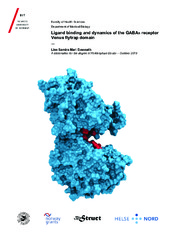| dc.contributor.advisor | Ingebrigt, Sylte | |
| dc.contributor.author | Evenseth, Linn Samira Mari | |
| dc.date.accessioned | 2020-01-09T09:49:27Z | |
| dc.date.available | 2020-01-09T09:49:27Z | |
| dc.date.issued | 2019-11-15 | |
| dc.description.abstract | <p>The gamma-amino-butyric-acid (GABA) is the main inhibitory neurotransmitter in the central nervous system (CNS) and exerts its physiological role by binding to the ionotropic GABA<sub>A</sub> and GABA<sub>C</sub> receptors and the metabotropic GABA<sub>B</sub> receptor (GABA<sub>B</sub>-R). The GABA<sub>B</sub>-R is an obligate heterodimer that belongs to class C of guanine-binding proteins (G-protein) coupled receptors (GPCRs). Each monomer, GABA<sub>B1a/b</sub> and GABA<sub>B2</sub>, is comprised of an extracellular bi-lobed domain connected by a short loop to a heptahelical transmembrane domain (7TM). The extracellular domain is called the Venus flytrap (VFT) due to the architectural and mechanical resemblance to the carnivorous flower. The GABA<sub>B1a/b</sub> VFT contains the orthosteric GABA binding site, while the 7TM domain of GABA<sub>B2</sub> hosts an allosteric binding site and is responsible for binding of G-proteins.
<p>Previous studies have shown that the GABA<sub>B</sub>-R is associated with numerous neurological and neuropsychiatric disorders including learning and memory deficits, depression and anxiety, addiction and epilepsy. The role of GABA<sub>B</sub>-R in pathophysiology makes it an exciting target for drug interventions, especially since there is only one drug on the market targeting the receptor, the agonist baclofen.
<p>In the present study, we tested the applicability of both classical structure-based and ligand-based methods in a virtual screening (VS) workflow using databases containing in total 8.2 million compounds, to discover novel orthosteric ligands targeting the GABA<sub>B</sub>-R. A total of 34 ligands were purchased and tested in a functional cAMP assay. Currently, two of the compounds have showed antagonistic properties. We also used classical molecular dynamics (MD) simulations in combination with metadynamics to gain insight into the structural movements of the VFT. The results show that the barrier between the open and closed conformation is high, indicating that a ligand might be needed for receptor transition between the open/inactive and closed/active states, but additional simulations are needed to confirm the result. | en_US |
| dc.description.doctoraltype | ph.d. | en_US |
| dc.description.popularabstract | One of the most important neurotransmitters in the central nervous system is called gamma-amino-butyric-acid (GABA). GABA binds to three important receptors; GABAA, GABAB and GABAC receptors. The GABAB receptor is associated with a numerous neurological and neuropsychiatric disorders, but there is only one drug on the marked that targets this receptor.
In this study, we used computer-based methods to screen virtual libraries to identify new potential drug candidates that can bind to one of the binding sites in this receptor. We also performed a computer-based simulation of the receptor to try to understand how it behaves in its natural environment. Our current results show that we have two new compounds that can bind to the receptor. | en_US |
| dc.description.sponsorship | The work presented in this study was performed at the University of Tromsø, the Institute of Pharmacology in Krakow and The University of Bologna. The study was supported by the Polish-Norwegian Research Program under the Norwegian Financial Mechanism 2009-2014 in the frame of Project PLATFORMex (Pol-NOR/198887/73/2013) and by Helse Nord project number HNF1426-18. The project was also supported by Biostruct and UiT The Arctic University of Norway. | en_US |
| dc.identifier.isbn | 978-82-7589-653-5 | |
| dc.identifier.uri | https://hdl.handle.net/10037/17041 | |
| dc.language.iso | eng | en_US |
| dc.publisher | UiT The Arctic University of Norway | en_US |
| dc.publisher | UiT Norges arktiske universitet | en_US |
| dc.relation.haspart | <p>Paper I: Evenseth, L.M., Warszycki, D., Bojarski, A.J., Gabrielsen, M. & Sylte, I. (2019). In Silico Methods for the Discovery of Orthosteric GABA<sub>B</sub> Receptor Compounds. <i>Molecules, 25</i>(5), 935. Also available in Munin at <a href=https://hdl.handle.net/10037/15911>https://hdl.handle.net/10037/15911</a>.
<p>Paper II: Evenseth, L.S.M., Wushur, I., Warszycki, D., Bojarski, A.J., Gabrielsen, M. & Sylte, I. Identification of orthosteric GABA<sub>B</sub> receptor compounds by Virtual Screening. (Manuscript). Available in the file “thesis_entire.pdf”.
<p>Paper III: Evenseth, L.S.M., Ocello, R., Gabrielsen, M., Masetti, M., Sylte, I. & Cavalli, A. Exploring the conformational dynamics of the extracellular Venus flytrap domain of the GABA<sub>B</sub> receptor: a path-metadynamics study. (Manuscript). Available in the file “thesis_entire.pdf”. | en_US |
| dc.rights.accessRights | openAccess | en_US |
| dc.rights.holder | Copyright 2019 The Author(s) | |
| dc.rights.uri | https://creativecommons.org/licenses/by-nc-sa/4.0 | en_US |
| dc.rights | Attribution-NonCommercial-ShareAlike 4.0 International (CC BY-NC-SA 4.0) | en_US |
| dc.subject | VDP::Medical disciplines: 700::Health sciences: 800 | en_US |
| dc.subject | Computational Chemistry | en_US |
| dc.subject | Modelling | en_US |
| dc.subject | GABAB | en_US |
| dc.title | Ligand binding and dynamics of the GABAB receptor Venus flytrap domain | en_US |
| dc.type | Doctoral thesis | en_US |
| dc.type | Doktorgradsavhandling | en_US |


 English
English norsk
norsk

